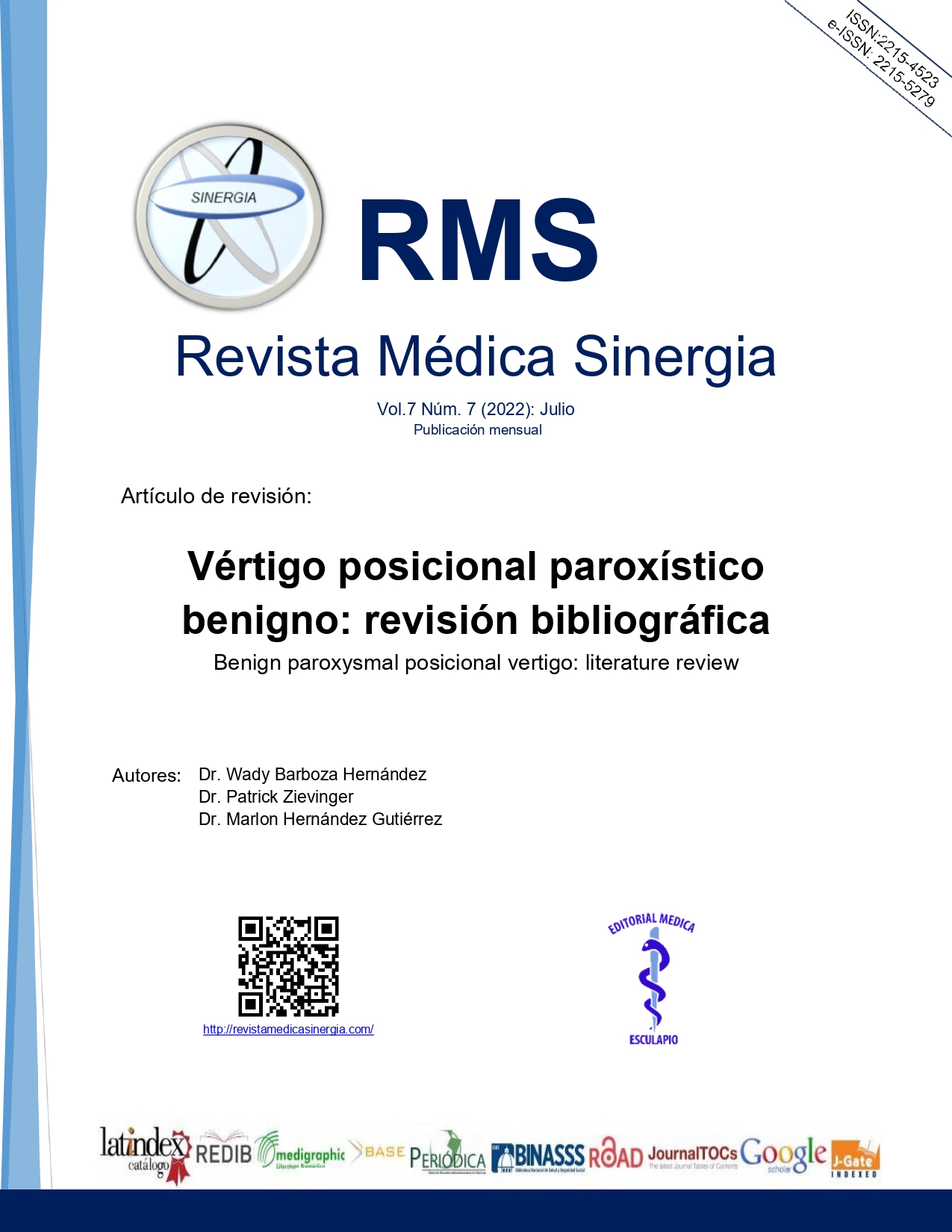Abstract
Benign paroxysmal positional vertigo is the most common labyrinthine disorder caused by mechanical stimulation of vestibular receptors within the semicircular canals. It is characterized by positional vertigo and nystagmus, both caused by abrupt changes in the position of the head relative to gravity. BPPV is by far the most common cause of vertigo in adults. The cumulative lifetime incidence in the general population is around 10%. The incidence increases in those over 60 years of age and decreases exponentially below 40 years of age, being very rare in children. Women are more commonly affected than men. As for the diagnosis, it is usually clinical, obtained through an exhaustive clinical history and physical examination aimed at vestibular and neurological assessment, emphasizing some semiological maneuvers such as Dix-Hallpike and Roll Test. It is very important, given the reason for consulting dizziness/vertigo, to initially identify those circumstances that reflect significant compromise in the patient's health. A key point in the diagnosis is the differentiation between peripheral and central vertigo. The management of the pathology is basically based on two strategies: the pharmacological option, which can have an important role in the short-term control of the symptoms of the autonomic nervous system, such as nausea, paleness or vomiting. The other option corresponds to the techniques of repositioning canals or Epley maneuvers, with which, if the symptoms of vertigo are relieved, definitively in many cases.
Keywords
References
-Argente H, Álvarez M. Semiología Médica, fisiopatología, semiotecnia y propedéutica. 2da ed. Buenos Aires: Editorial Panamericana; 2013.
- Bhattacharyya N, Gubbels SP, Schwartz SR, Edlow JA, El-Kashlan H, Fife T, et al. Clinical practice guideline: Benign paroxysmal positional vertigo (update). Otolaryngol Head Neck Surg. 1ero de marzo, 2018 [citado 20 de febrero 2022]; 156 (3): 1–47. Disponible en https://doi.org/10.1177/0194599816689667
-Nuti D, Masini M, Mandalà M. Benign paroxysmal positional vertigo and its variants. Handb Clin Neurol. 1ero marzo, 2016 [citado 20 de febrero 2022];137 (1):241–256. Disponible en https://doi.org/10.1016/B978-0-444-63437-5.00018-2
-Balatsouras D, Koukoutsis G, Fassolis A, Moukos A, Aspris A. Benign paroxysmal positional vertigo in the elderly: current insights. Clin Interv Aging. 5 de noviembre, 2018 [citado 27 de febrero 2022];13 (1): 2251–2266. Disponible en https://doi.org/10.2147/CIA.S144134
- Moore KL, Agur A. Fundamentos de anatomía con orientación clínica. 5ta ed. la Ciudad Condal, España: Lippincott Williams & Wilkins; 2015.
-11-Muncie HL, Sirmans SM, James E. Dizziness: Approach to evaluation and management. Am Fam Physician. 10 de enero 2017 [citado 3 de marzo 2022];95 (3):154–162. Disponible en http://www.aafp.org/ afp/2017/0201/p154-s1.html
-Carnevale C, Muñoz-Proto F, Rama-López J, Ferrán-de la Cierva L, Rodríguez-Villalba R, Sarría-Echegaray P, et al. Manejo del vértigo posicional paroxístico benigno en atención primaria. Med. Fam. Semergen. 6 de enero 2014 [citado 4 de marzo 2022];40(5):254–260. Disponible en http://dx.doi.org/10.1016/j.semerg.2014.01.001
-Omron R. Peripheral vertigo. Emerg Med Clin North Am. 9 de abril 2019 [citado 4 de marzo 2022];37(1):11–28. Disponible en https://doi.org/10.1016/j.emc.2018.09.004
-Imai T, Takeda N, Ikezono T, Shigeno K, Asai M, Watanabe Y, et al. Classification, diagnostic criteria and management of benign paroxysmal positional vertigo. Auris Nasus Larynx.13 de marzo 2016 [citado 8 de marzo 2022];44(1):1–6. Disponible en http://dx.doi.org/10.1016/j.anl.2016.03.013
-Gallardo J, Escalona L, Moreno S, Fernández J. Vértigo posicional paroxístico benigno: el vértigo que todos debemos conocer. Anales médicos, asoc. Med ABC. 16 de diciembre 2019 [citado 16 de marzo 2022]; 64 (4): 281-289. Disponible en http://dx.doi.org/10.35366/BC194I
-Verdecchia DH, Hernandez D, Andreu MF, Salzberg SE, Whitney SL. Diagnóstico del vértigo posicional paroxístico benigno del canal semicircular posterior AJRPT. 10 de enero 2020 [citado 16 de marzo 2022];2(2): p48-51. Disponible en http://www.ajrpt.com
-Yao Q, Song Q, Wang H, Shi H, Yu D. Benign paroxysmal positional vertigo in children. Clin Otolaryngol. 20 de enero [citado 16 de marzo 2022] , 2019;44(1):21–25. Disponible en http://dx. doi: 10.1111/coa.13226
-16- Harrison TR, Resnick W, Fauci A, Kasper D, Root R, Wilson D et. Al. Principios de Medicina Interna. 19a ed. Nueva York, NY, Estados Unidos de América: McGraw-Hill Professional Publishing; 2016.
-Jeong S-H, Kim J-S, Kim H-J, Choi J-Y, Koo J-W, Choi K-D, et al. Prevention of benign paroxysmal positional vertigo with vitamin D supplementation: A randomized trial: A randomized trial. Amer. Academy Neurology. 5 de agosto 2020 [citado 3 de marzo 2022];95(9):1117–1125. Disponible en http://dx.doi:10.1212/WNL.0000000000010343
-Bressi F, Vella P, Casale M, Moffa A, Sabatino L, Lopez MA, et al. Vestibular rehabilitation in benign paroxysmal positional vertigo: Reality or fiction? Int J Immunopathol Pharmacol. 27 de marzo 20172020 [citado 3 de marzo 2022] 30(2):113–122. Disponible en http://dx.doi: 10.1177/0394632017709917

This work is licensed under a Creative Commons Attribution-NonCommercial 4.0 International License.
Copyright (c) 2022 Array


